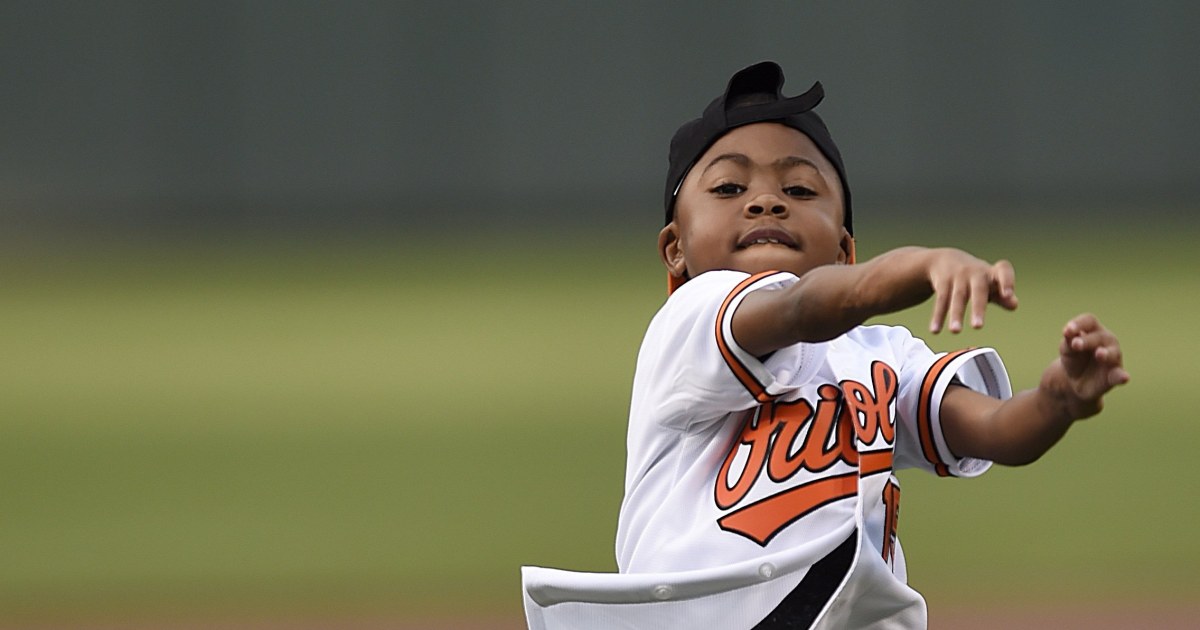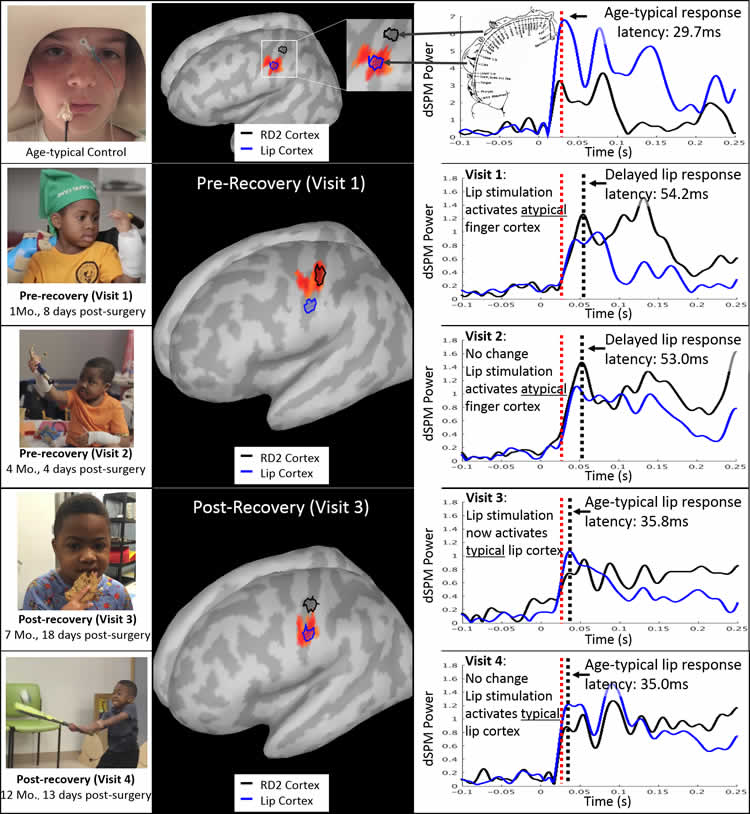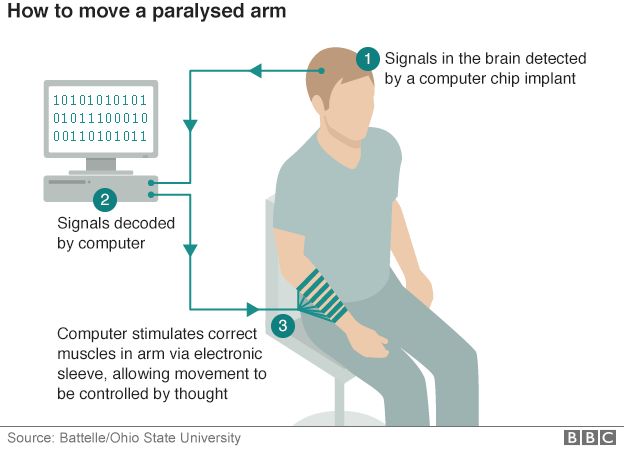Brain mapping shows child’s brain was “rewired” after double hand transplant
At age 2, Zion Harvey had his hands amputated due to a life-threatening infection. At age 8, he was the first child to receive a double hand transplant. He continues to amaze his family and doctors. One year after the transplant, he threw out the first pitch at a Baltimore Oriole’s baseball game. Fast forward one more year, and he’s in the news again.
U.S. News and World Report stated, “Zion Harvey was the first child to undergo a successful double hand transplant. Now he’s gaining notoriety for another milestone: the way his brain reorganized itself in response to the amputation and transplantation.”

Nine-year-old Zion Harvey, the world’s first child to receive a bilateral hand transplant, throws out the first pitch before the Baltimore Orioles and Texas Rangers baseball in Baltimore, Tuesday, Aug. 2, 2016. Image Credit: NBC News / Gail Burton / AP
Zion’s brain reacts
Each part of the body that receives nerve sensations sends electrical signals to a corresponding location in the brain. When you touch an ice cube with your fingertips, your brain processes the “cold” signal in a certain region. If the ice cube touches your lips, a different area of your brain receives a “cold” signal.
Previous brain imaging studies in adults showed that the brain remaps itself when it no longer receives signals from the hands following amputation. The region of the brain that typically processes signals from the hands is remapped and starts to process signals from nerves from other areas of the body. This remapping is called massive cortical reorganization (MCR).
MCR was observed in Zion as well. For Zion, his brain started to utilize the region that typically processed signals from his hands to process sensations from his lips.
“We had hoped to see MCR in our patient, and indeed, we were the first to observe MCR in a child,” stated William Gaetz, Ph.D., a radiology researcher, in a news release from Children’s Hospital of Philadelphia.
After his transplant, MCR was observed in Zion’s brain again, this time reverting to the pre-amputation mapping. His new hands were sending electrical signals, and over time, his brain remapped in order to process them in the correct region of the brain.
“For our patient, we found that the process is reversible,” continued Gaetz.
Mapping the regions of the brain that receive signals from Zion’s hands
Researchers used Magnetoencephalography (MEG), a non-invasive neuroimaging technique, to detect the location, signal strength and timing of the Zion’s responses to sensory stimuli applied lightly to his lips and fingers. MEG offers higher spatial resolution compared to common EEGs. It’s also far more comfortable for the patient compared to fMRI, which is especially helpful when studying children who tend to be squirmy.
Once the imaging was complete, the researchers used Brainstorm to perform data analysis for this study. Brainstorm is a MATLAB community toolbox for MEG analysis.
The team performed MEGs four times on Zion in the year following his hand transplant. They also performed similar tests on five healthy children who served as controls. Their findings are shared in a paper published in the Annals of Clinical and Translational Neurology.
- At first, just after the transplant, Zion’s fingertips did not respond to touch. When experimenters touched his lips, the MEG signal registered in the hand area of the brain’s cortex, but with a delay of 20 milliseconds compared to controls. This showed that his brain had remapped the region of his brain associated with sensory reception in his hands after the amputation.
- After two visits, MEG signals from lip stimulation had returned to the lip region of the brain, with a normal response time. This indicated that his brain mapping was reverting to a more normal pattern.
- One year after the transplant, touching Zion’s fingertip caused MEG signals to appear in the region of the brain associated with the hand. There was a short time delay, and the signal strength was higher than normal. His brain was once again remapping regions associated with sensory reception in his hand. He could feel things with his new hands.
“The sensory signals are arriving in the correct location in the brain, but may not yet be getting fully integrated into the somatosensory network,” stated Gaetz. “We expect that over time, these sensory responses will become more age-typical.”
Great results, leading to new questions
For Zion, this showed that his brain was re-learning to feel sensations (process electrical signals) from his hands. This also means he can throw a wicked first pitch at a baseball game or tie his shoes on his own.
For science, this study demonstrated brain plasticity, both following amputation and transplantation. It means a brain can re-learn the sense of touch after a hand transplant.
“These results have raised many new questions and generated excitement about brain plasticity, particularly in children. Some of those new questions include, what is the best age to get a hand transplant? Does MCR always occur after amputation? How does brain mapping look in people born without hands? Would we see MCR reverse in an adult, as we did in this patient? We are planning new research to investigate some of these questions,” stated Gaetz.
Click here if you’d like to learn more about Brainstorm and MEG analysis.
 Cleve’s Corner: Cleve Moler on Mathematics and Computing
Cleve’s Corner: Cleve Moler on Mathematics and Computing The MATLAB Blog
The MATLAB Blog Guy on Simulink
Guy on Simulink MATLAB Community
MATLAB Community Artificial Intelligence
Artificial Intelligence Developer Zone
Developer Zone Stuart’s MATLAB Videos
Stuart’s MATLAB Videos Behind the Headlines
Behind the Headlines File Exchange Pick of the Week
File Exchange Pick of the Week Hans on IoT
Hans on IoT Student Lounge
Student Lounge MATLAB ユーザーコミュニティー
MATLAB ユーザーコミュニティー Startups, Accelerators, & Entrepreneurs
Startups, Accelerators, & Entrepreneurs Autonomous Systems
Autonomous Systems Quantitative Finance
Quantitative Finance MATLAB Graphics and App Building
MATLAB Graphics and App Building








Comments
To leave a comment, please click here to sign in to your MathWorks Account or create a new one.